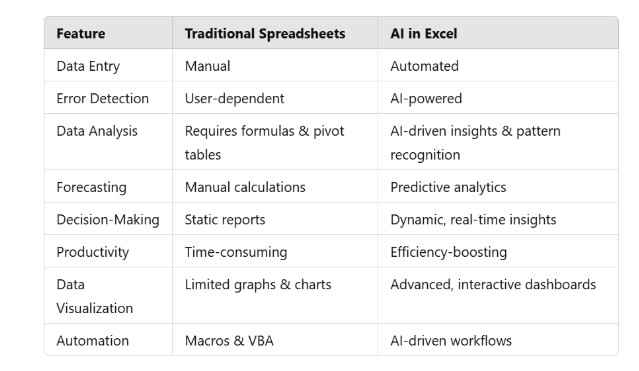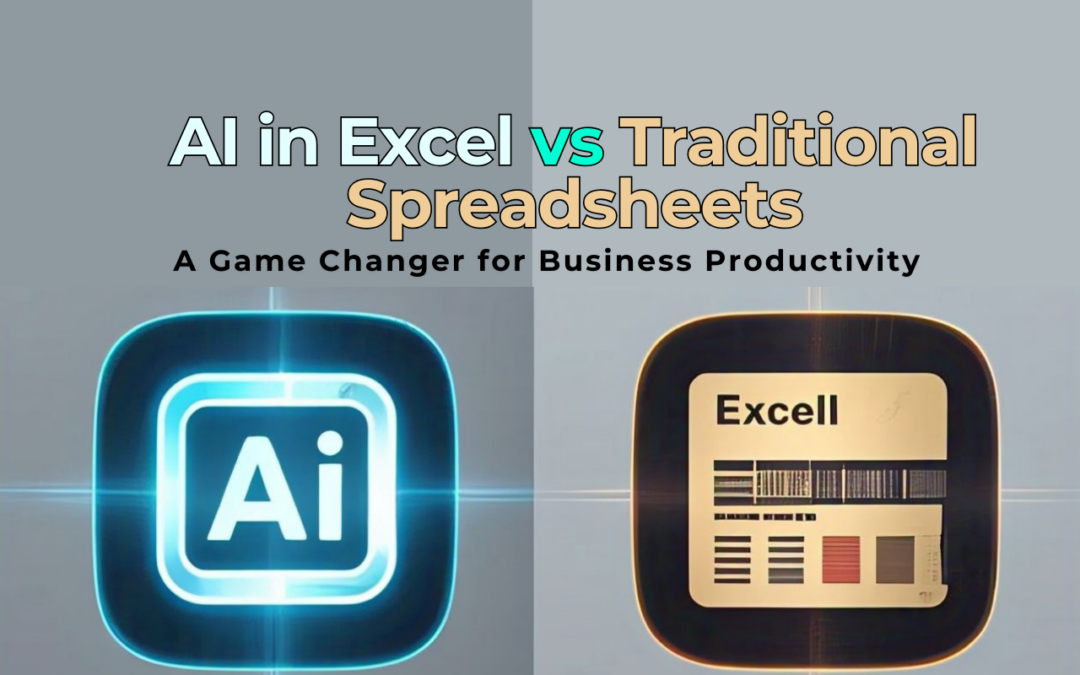In today’s data-driven world, businesses rely heavily on spreadsheets for financial analysis, data management, and decision-making. Microsoft Excel has long been the gold standard, with traditional spreadsheets offering powerful tools for calculations, reporting, and record-keeping. However, the integration of Artificial Intelligence (AI) into Excel is transforming how businesses analyze and interpret data, significantly improving productivity. But how does AI in Excel vs to traditional spreadsheets? Let’s explore the differences and the impact on business efficiency.
Traditional Spreadsheets: The Backbone of Data Management
Traditional spreadsheets have been the foundation of business operations for decades, providing essential functionalities such as:
- Formulas and Functions: Businesses use built-in formulas like SUM, VLOOKUP, and IF statements to process data.
- Pivot Tables: These allow users to summarize and analyze large datasets efficiently.
- Manual Data Entry and Analysis: Users input and manipulate data manually, requiring time and effort.
- Static Reporting: Reports are based on predefined inputs, limiting dynamic decision-making.
- Error-Prone Processes: Human errors, such as incorrect formulas or data entry mistakes, can impact accuracy.
- Limited Automation: Macros and VBA provide automation, but they require programming knowledge and are limited in scope.
While traditional spreadsheets are powerful, they require significant manual effort, making them inefficient for handling large datasets and complex analyses.
AI in Excel: A Paradigm Shift in Business Productivity
With the rise of AI, Excel has evolved beyond its traditional functionalities. Microsoft introduced AI-powered features that automate processes, provide predictive insights, and enhance decision-making. Some key AI-driven capabilities in Excel include:
1. Data Analysis and Pattern Recognition
AI in Excel can automatically detect patterns and trends in large datasets, making it easier for businesses to gain actionable insights without complex formulas. Machine learning algorithms can identify anomalies, outliers, and correlations that would otherwise take hours of manual work.
2. Automated Data Cleaning and Error Detection
Traditional spreadsheets require users to manually identify and fix errors. AI automates data cleaning by identifying inconsistencies, duplicates, and missing values, saving time and improving accuracy. AI tools like Power Query enhance this capability by transforming raw data into structured formats seamlessly.
3. Natural Language Queries
Instead of using complex formulas, users can ask Excel questions in plain language. AI-driven tools, such as Excel’s “Ideas” feature, generate insights without requiring advanced spreadsheet knowledge. This democratizes data analysis, allowing non-technical users to make data-driven decisions easily.
4. Predictive Analytics and Forecasting
AI can analyze historical data to predict future trends. Businesses use this feature for financial forecasting, sales predictions, and inventory management, reducing reliance on static reports. Machine learning algorithms can refine models over time, increasing the accuracy of predictions.
5. Integration with Power BI and Other AI Tools
AI in Excel seamlessly integrates with Power BI and cloud-based AI services, enabling real-time data analysis and advanced visualization. Businesses can connect live data sources, generate interactive reports, and gain deeper insights without manual intervention.
6. Automated Reporting and Dashboards
Traditional spreadsheets require manual updates for reports and dashboards. AI-driven automation tools allow real-time updates, reducing manual workload and ensuring data accuracy. Excel’s integration with Power Automate further streamlines business processes.
7. AI-Driven Decision Support
AI can analyze different business scenarios and suggest optimal solutions. Whether it’s budget allocation, resource planning, or market trend analysis, AI enhances decision-making by providing data-backed recommendations.
The Business Impact: AI vs. Traditional Spreadsheets

Real-World Use Cases of AI in Excel
1. Financial Analysis and Budgeting
Finance teams use AI-powered Excel to analyze expenses, forecast revenue, and detect anomalies in transactions. Predictive models help businesses make proactive financial decisions, reducing risks.
2. Sales and Marketing Optimization
AI-enhanced spreadsheets allow marketing teams to analyze customer behavior, track campaign performance, and predict market trends. Automated insights help refine marketing strategies for better ROI.
3. Supply Chain Management
AI assists businesses in inventory forecasting, order optimization, and demand prediction. Automated trend detection minimizes supply chain disruptions and improves operational efficiency.
4. HR and Workforce Analytics
Companies use AI-driven Excel for talent management, attrition prediction, and performance analysis. AI helps HR teams make data-driven hiring and retention strategies.
5. Healthcare Data Management
Hospitals and research institutions leverage AI in Excel to analyze patient data, detect disease patterns, and improve treatment plans, leading to better healthcare outcomes.
Challenges of Implementing AI in Excel
Despite its benefits, AI integration in Excel comes with challenges:
- Learning Curve: Employees need to upskill to effectively utilize AI-powered features.
- Data Privacy Concerns: AI relies on large datasets, raising security and compliance issues.
- Integration with Legacy Systems: Businesses may face challenges integrating AI-driven Excel with older software.
- Cost of Advanced Features: While AI in Excel enhances productivity, some features require additional licensing fees.
Why AI in Excel is a Game Changer
The integration of AI in Excel is revolutionizing the way businesses operate by:
- Saving Time: AI automates repetitive tasks, allowing employees to focus on strategic decision-making.
- Enhancing Accuracy: AI minimizes human errors and improves data reliability.
- Improving Decision-Making: Real-time insights help businesses make informed, data-driven choices.
- Scaling Operations: AI-powered Excel can handle vast datasets that would be challenging for traditional spreadsheets.
- Increasing Efficiency: Automated workflows streamline operations, reducing administrative overhead.
- Enabling Competitive Advantage: Companies leveraging AI-driven Excel gain deeper insights, allowing them to stay ahead in the market.
Conclusion
AI in Excel vs traditional spreadsheets has served businesses well, AI in Excel is redefining business productivity by automating processes, improving data accuracy, and providing predictive insights. Companies that leverage AI in Excel vs traditional spreadsheet tools can streamline operations, reduce manual workload, and make smarter decisions, ultimately gaining a competitive edge in today’s fast-paced business environment.
AI-powered Excel is not just an enhancement—it’s a necessity for businesses looking to stay competitive in the digital age. As AI continues to evolve, its impact on spreadsheet management will only grow, making it an essential tool for forward-thinking businesses.
Are you ready to embrace AI in Excel vs traditional spreadsheets for your business productivity? Start exploring AI-driven features in Excel today and revolutionize your data management practices!











